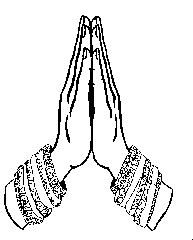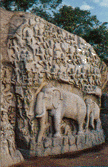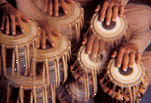India's Culture
 Modern day Indian culture has been influenced by foreign invaders, settlers and colonizers. This has often left people wondering as to the origins of Indian culture. The present theory is that Dravidians were the original settlers who were chased to the south by the Aryans during their migrations from Central Asia. With time however, their traditions merged and as a result, throughout India today, traditions are quite similar.
Modern day Indian culture has been influenced by foreign invaders, settlers and colonizers. This has often left people wondering as to the origins of Indian culture. The present theory is that Dravidians were the original settlers who were chased to the south by the Aryans during their migrations from Central Asia. With time however, their traditions merged and as a result, throughout India today, traditions are quite similar.
India is rich in her ceremonial greetings. Each gesture is meaningful and bears its own name: Namaste, Vanakkam, Swagattam, Sat Sri Akal and many more, signifying respect and welcome, blessings and greetings. The most universal is the soft-spoken Namaste. Swagattam or welcome is expressed in a hundred different ways appropriate to a land as rich, vast and varied as India. As someone once said, "If there is one place on the face of the earth where all the dreams of living men have found a home from the very earliest days when man began to dream of existence, it is India."
Languages
With over 1600 languages and dialects, India's linguistic diversity is extreme. Three-fourths of the population speak languages belonging to the Indo-Aryan group of the Indo-European family, all of which ultimately descend from Sanskrit. These include Hindi, Assamese, Bengali, Gujarati, Kashmiri, Marathi, Oriya, Punjabi, Sindhi and Urdu, all enjoying official status. Nearly one-fourth of all Indians speak languages belonging to the Dravidian family, among which Kannada, Malayalam, Tamil, and Telugu have official status. Hundreds of additional languages, grouped in several families, account for less than 5 percent of the population. English, an auxiliary official language, serves as an all-Indian lingua franca.
Linguistic diversity in India had far-reaching political repercussions as the structure was used as a basis for the formation of the first 14 states of the Indian republic. Nine other parts of India have more recently attained statehood and have their own languages. Hindi, is spoken by about 40 percent of the population and covers most of the northen states. School children in Maharashtra learn Marathi, Gujarati in Gujarat, Punjabi in Punjab, Oriya in Orissa, Bengali in Bengal, Malayalam in Kerala, Telugu in Andhra Pradesh, Tamil in Tamil Nadu, Kannada in Karnataka and Kashmiri in Jammu & Kashmir. Assamese is usually spoke in the north-eastern states.
Art
 Indian art is a mix of indigenous and outside influences, yet having a unique character and distinctiveness of its own. It has changed with the evolution of a civilization which was full of remarkable innovations in all areas of artistic expression and features spirals and curvaceous lines, vines and tendrils, round-figured goddesses, circular amulets, colored gemstones, arches and domes, hallowed deities, crescent moons, and the globe of the sun. Indian sculptures and paintings depict the diversity, color and spontaneity of this country and are representations of the all-encompassing nature of Indian culture. Art in India is vivid and lively, refined and sophisticated and bold and vigorous at the same time. From being essentially religious in purpose in the beginning, Indian paintings and sculpture have evolved over the years to become a fusion of various traditions which influenced them.
Indian art is a mix of indigenous and outside influences, yet having a unique character and distinctiveness of its own. It has changed with the evolution of a civilization which was full of remarkable innovations in all areas of artistic expression and features spirals and curvaceous lines, vines and tendrils, round-figured goddesses, circular amulets, colored gemstones, arches and domes, hallowed deities, crescent moons, and the globe of the sun. Indian sculptures and paintings depict the diversity, color and spontaneity of this country and are representations of the all-encompassing nature of Indian culture. Art in India is vivid and lively, refined and sophisticated and bold and vigorous at the same time. From being essentially religious in purpose in the beginning, Indian paintings and sculpture have evolved over the years to become a fusion of various traditions which influenced them.
 The greatest art dynasties were the Mauryans who ruled over the whole of India during 3 BC. Sculpture has always been the most popular form of art, possibly since it serves not only to satisfy creative urges but can also be used to portray symbols of the empire. In fact, the Mauryan pillar with its four lions has been adopted as the seal of independent India. Examples of Mauryan art can be seen in museums all over India.
The greatest art dynasties were the Mauryans who ruled over the whole of India during 3 BC. Sculpture has always been the most popular form of art, possibly since it serves not only to satisfy creative urges but can also be used to portray symbols of the empire. In fact, the Mauryan pillar with its four lions has been adopted as the seal of independent India. Examples of Mauryan art can be seen in museums all over India.
During the Gupta dynasty, the cave paintings and sculptures of Ajanta and Ellora were executed in fine detail. Their excellence has been unparalleled in the world. Another fine example of Indian art is the Nataraja, or the dancing Shiva traces its origins to the Pallava dynasty in southern India. Shiva, the Lord of Destruction, is depicted in his performance of his Cosmic Dance of Destruction in which he dances with a composed face in spite of a sense of energy in the posture of his body and the flurry of his hands while the universe around him descends in flames.
In India, one can also find innumerable temples, fortresses and palaces that exhibit excellent examples of Indian architecture through the ages. Sustained invasions however have meant a loss of much of the earlier examples of Indian architecture. Much of what is seen today dates back from the Mughal era. The finest example of pure Hindu skills applied to fort building can be seen in the Gwalior fort. The Mughals built impressive memorials for their dead, as in Humayun's Tomb in Delhi, as well as the famous Taj Mahal at Agra.
Music
 India is a country with many different forms of music, the most popular form of which heard today are film songs. However, India also has many unique regional forms of music which can be classified as: devotional and ritual music, seasonal songs and dance, functional and social items, ballads and narrative forms.
India is a country with many different forms of music, the most popular form of which heard today are film songs. However, India also has many unique regional forms of music which can be classified as: devotional and ritual music, seasonal songs and dance, functional and social items, ballads and narrative forms.
Seasonal songs relate to harvests and sowing, or to festivals like Holi and Diwali which are common throughout the country. Ballads, the songs of legendary heroes and heroines, are sung by professional musicians to the accompaniment of drums and cymbals. Devotional music in India is, perhaps, the next most popular form after film songs. Visiting a church in Goa, Madras or Calcutta you can hear familiar hymns sung in Portugese, Tamil, Bengali, or English. Bhajans (hymns) sung in the different Indian languages are songs sung in praise of various Hindu deities.
Apart from regional forms of music, there are two broad systems of classical music that dominate the scene today. Hindustani music of northern India and Carnatic music which is more popular in the southern states of Kerala, Tamil Nadu, Andhra Pradesh and Karnataka.
Dance
 Similar to the musical tradition, there are several forms of dance in India that are related to the celebration of festivals and social functions such as marriage and rituals. Classical dance forms in India include Bharatnatyam from Tamil Nadu and South India, Kuchipudi from Andhra Pradesh, Odissi from Orissa, Kathakali from Kerala, Kathak from northern India and Manipuri from the north-eastern state of Manipur.
Similar to the musical tradition, there are several forms of dance in India that are related to the celebration of festivals and social functions such as marriage and rituals. Classical dance forms in India include Bharatnatyam from Tamil Nadu and South India, Kuchipudi from Andhra Pradesh, Odissi from Orissa, Kathakali from Kerala, Kathak from northern India and Manipuri from the north-eastern state of Manipur.
Most of the classical dance forms seem to have evolved from a single generic source. The Natyashastra is a Sanskrit compilation of the basic components of Indian music, dance and drama. The text is believed to have been written between 2 BC and 2 AD. The text explains the essential ingredients of dance: music, composition, movements, the role of costumes, hastas (hand gestures) and the use of facial and body postures that can be employed to convey expression through the medium of dance. All the classical dances of India follow these codes, though each form has unfolded and blossomed through its own individual expression.
Literature
The earliest known records are the Vedas and the Puranas both of which were not authored by a single author but are a collective pool of the learning, wisdom, religion and philosophy of the great sages of the past. This was followed by the Mahabharata and the Ramayana, both written several centuries before the dawn of the Christian era. Other major works include Shankuntala, Nala-Damayanti, Panchatantra, all of which were written in Sanskrit.
Since the coming of the British, Indian literature underwent a renaissance with the rise of nationalist writers writing in vernacular languages. The freedom struggle produced a number of original writers, among them was the poetess Sarojini Naidu. Famous writers in modern day India include Ruskin Bond, VS Naipaul, Nirad Chaudhari, RK Narayan, Khushwant Singh, Vikram Seth and Salman Rushdie among others.
Engineering & Medicine
Indian mathematicians are credited with introducing the concept of zero to the world. There is plenty of evidence that ancient India had a very strong interest in astronomy. Ayurveda, India's indigenous form of medicine, is still popular throughout the country and indeed the world. Archaeologists have found ancient India to have a very high degree of town planning in terms of straight roads, sophisticated sewage systems, granary storage and public baths.
Social Issues
Social legislation in India has done much to alleviate the disabilities previously suffered by formerly untouchable castes, tribal populations, women, and other disadvantaged segments of society. Due to its size and nature, it is only natural that the government has not been able to tackle every social problem. This has led to the mushrooming of several non-governmental organizations (NGOs) to protect and promote the interests of women and children. NGOs run facilities that provide basic health and child care services, run homes for the destitute & distressed and provide education and training opportunities.
Media
In India the print and the electronic media are both very active and free. The publications in the country are in Hindi, English and all vernacular languages. While most of the print media is privately-run, the TV networks are in the hands of the government. In the recent past, the electronic media has come in for a major change with global TV networks making their presence felt.
The Prasar Bharati Act (India's Communications policy) promises autonomy of the state-run TV networks. It however is being implemented slowly. The most popular foreign TV network is Star TV. Broadcasting out of Hong Kong via satellite it reaches a couple of million households; however it is no match for the reach and popularity of the state-run, Doordarshan.